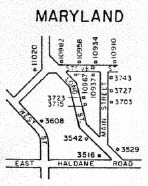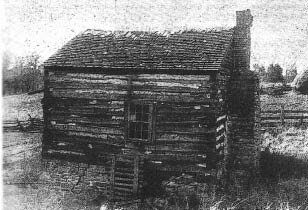
Discover rewarding casino experiences. 
Click on the Flag for More Information |
In the summer of 1836 two well-to-do gentlemen, lé eastern entrepreneurs, came to Illinois to look over the prairies they’d been hearing about. Not only did Samuel Hitt and Nathaniel Swingley minutely investigate what they found, they immediately took up claims of thousands of acres in Ogle County, mostly around the site of what would become Mt. Morris. They returned to their homes in Maryland to sing the praises of the well-watered lands with sporadic but heavily timbered groves and the prospects of the entire. Hitt and Swingley were just in their thirties when they undertook that trek westward; full of spirit and energy, and what became evident in that near future, ready and willing to launch projects to make them more money by investing widely in businesses and acreages that at that period were lucrative. They returned to the site of their major purchases in the spring of 1837 with their families and eleven other men, three of whom brought their families also. Just two years after their arrival the site of a college began to take form so dedicated to education and religion were they that no other buildings graced the site of what would become Rock River Seminary, a Methodist school in the wilderness at the prospective town of Mt. Morris. It was named for a Methodist bishop. Sometimes commitment outweighed practicality. The two original expeditionists had passed the winter recruiting men to come with them and who were to be paid a dollar a day for services such as breaking the prairie, sowing and harvesting crops, building cabins and fences for all, and etcetera, etcetera. Besides the wives of three of the workers, Elizabeth Ankeny, sister of Swingley, and her two children came also. The expedition went from Maryland, mostly Washington County, to Wheeling, West Virginia to load aboard boats taking the Ohio, Mississippi and Illinois rivers to Peru, Illinois where they again came by covered wagons to Ogle County. They came to what became known as Fridley’s Grove which had recently been vacated by Thomas Ford who’d purchased several hundreds of acres thereabout but had decided on another course, that in the law. He became circuit court judge, then the governor of Illinois in 1842. Some of the Marylanders lived in the vacant cabin while other cabins wee being constructed. Mrs. Ankeny and children and the Eli Householders on one side, while three Stover brothers and Bill McDannel lived in the other. Meanwhile, all of them resided in the cabin seen here, it taken from “Mt. Morris, Past and Present.” Others in the group were Bovey, Niehoff, Grove, Finkbohnar, and two Meyers’. The names of subsequent parties are readily found, too. These rustic beginnings doesn’t mean that some cultural and social higher level wasn’t attained by most of them in later years. A bake oven was constructed at Mrs. Ankeny’s for food preparation for the party. They slept on “wagoner beds,” plain mattresses rolled up during the day to be spread on the floor at night. Humble but adequate. Adaptability was the byword as they all looked to the future. Swingley kept the men busy whom he’d recruited. In one reference it states that Hitt had “indentured workers.” He and his traveling partner meanwhile were very busy apparently occupied in broadening their investments and business including tinkering with the idea of a mill site in the central part of Carroll County, a claim owned at that time by Paul Otis and Granville Mathews, employees of the stage line aiming diagonally northwest ward across Carroll County to the lead mines then the much traveled Peoria-Galena trail via Dixon’s Ferry. Samuel Hitt, Nathaniel Swingley, Daniel Christian and George Swaggert formed a mill company to develop a water power in 1837 for which they paid $1,400. For some reason they did not make any improvements so it lay fallow until 1841 when Nathaniel Halderman and David Emmert took it up for payment of $3,000. Source says that the previous company (of four) had dissolved having made a division of property sometime previously. As the mill site was developed so did the town of Mt. Carroll which eventually became the county seat in 1843 when Savanna hadn’t committed to the building of a courthouse as had been ordained. Why division of the company had taken place and when, immediate reference doesn’t give but perhaps their Ogle County acreages kept Hitt and Swingley close to home although Hitt delved into the stage line business in Carroll County for a few years. In 1837, the time of Hitt’s arrival for residency, a deputy of his, George Harris, a Marylander also took charge of a crude inn on the newly developing stage line in central Carroll County at Cherry Grove (Freedom Township). Source says definitely that Harris was taking charge of Hitt’s interest and was not a settler. George Harris was in charge of the “inn,” a polite description for the fort/cabin Thomas Crane had built during the Black Hawk War (1832) as protection from the Indians. It still stood until Harris (in about 1840) built a commodious tavern up on the ridge above the old fort that became known as the Cherry Grove House (CG). Harris by then had his own ideas for business and moved on up the line to Plum River crossing for another inn. David Emmert took over the CG house and there made acquaintance of Nathaniel Halderman. Between them they developed a mill and Mt. Carroll. Emmanuel Stover came into possession of the Cherry Grove House by the time Lanark became a fact and moved that building to the new railroad depot soon after its inception. Hitt had bowed out of the inn business. During the fifties he had done so well that a stone manse was begun by him a few miles west of the growing Mt. Morris and the house stands yet today. Hitt died in 1859, far too young for a man of his abilities. Swingley went off to California to the Gold Rush but returned in a few years to Creston, Illinois where he died in 1870. More of Hitt later.
While emphasizing that the large emigrations to Ogle were Marylanders it can be noted also that when Carroll County was set off from JoDaviess County, it was left to the voters of the Cherry Grove precinct to name the new entity. History relates that “because they were mostly Marylanders in that precinct (of four) they chose the name of that “grand old patriot of Maryland, Charles Carroll,” signer of the Declaration of Independence. Most of that neighborhood were Marylanders, eh? Whether that’s so would take some research but we’ll take the writer’s word for it. Marylanders knew how to choose. We have so often heard that “we” were settled by the Pennsylvania Dutch but that was nearly 20 years later. Maryland has been lost, as least in Carroll. However, in Ogle the “Maryland Colony” is still familiar to many though a healthy one hundred sixty years old. In fact, a village “Maryland” was platted as you can see from the map here. Look for the way signs to Haldane off both Rts. 26 and 64, then go eat a few miles on Haldane Rd. There’s the Maryland platting. Also you’ll be able to discover the West Branch stone Church of the Brethren, West Grove and etc., an active community also, but later settlements some of whose residents came with the Marylanders originally. The cultural mix included also the Christ Adelphians whose members eschewed voting, military service and other worldly features as the earliest Brethren and Mennonites did, too. Ain’t history varied? It can be varied by nationality or religion or former residence such as the “Maryland Colony.” A drive up and down the roads of Maryland and Lincoln townships southeast of Forreston, northwest of Mt. Morris will help you understand the industrious, energetic, practical settlers of the yesterday who gave us the firm foundation we so appreciate today. Oh, yes, Heard of the “Canada Settlement” nearby the Maryland Colony? That’s another story.
|





